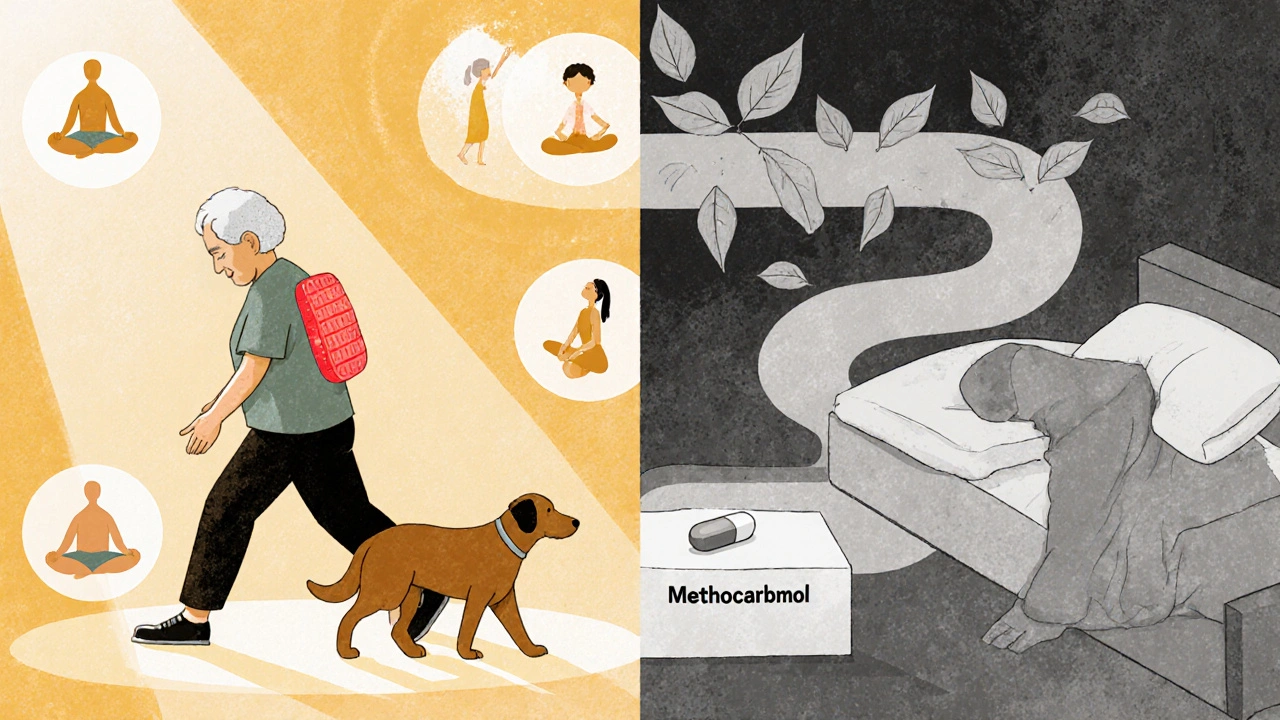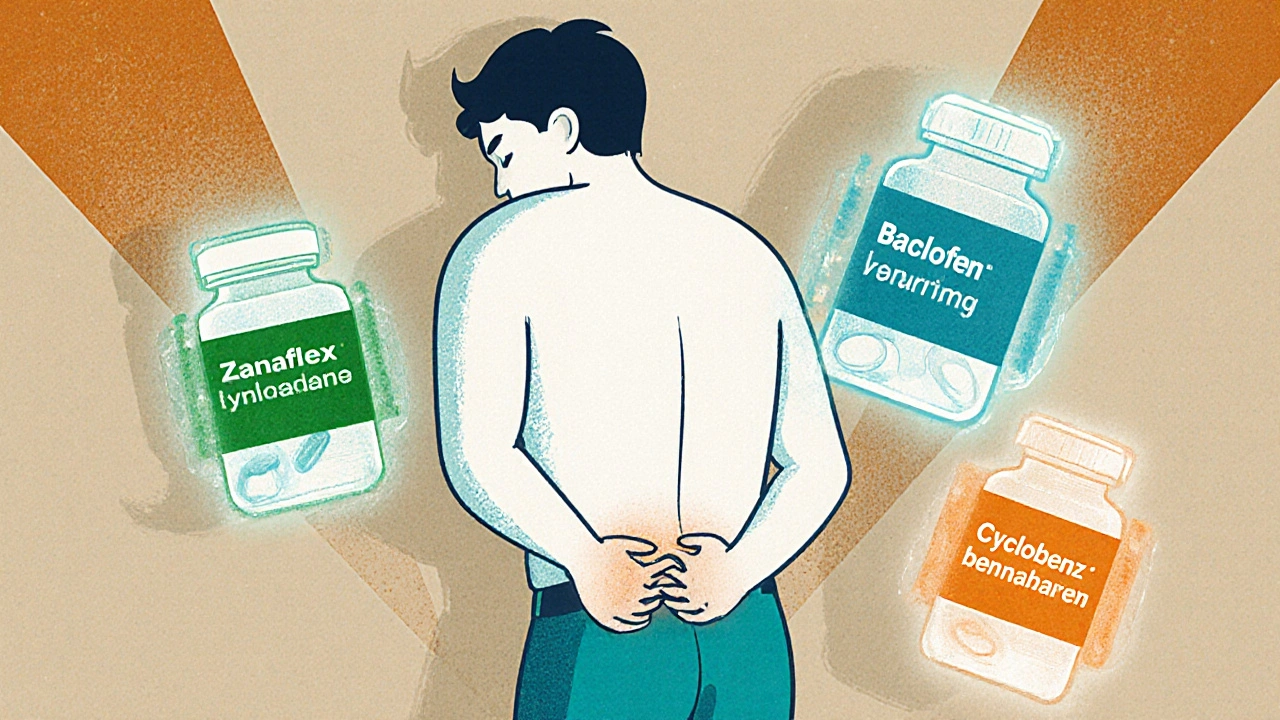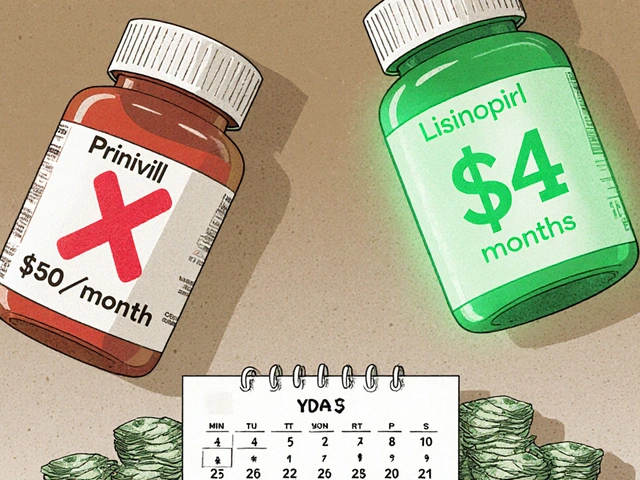When muscle spasms lock up your back, neck, or legs, it’s not just uncomfortable-it can stop you from moving, sleeping, or even working. Zanaflex (tizanidine) is one of the most commonly prescribed muscle relaxants for this, but it’s not the only option. Many people start with Zanaflex, only to find the side effects too strong or the relief too short-lived. That’s when they ask: tizanidine alternatives exist, but which ones actually work better for you?
How Zanaflex (Tizanidine) Actually Works
Zanaflex is the brand name for tizanidine, a short-acting muscle relaxant that works directly on your central nervous system. It doesn’t relax muscles by acting on the muscle fibers themselves. Instead, it dampens nerve signals from your spinal cord that cause muscles to tighten up. This makes it especially useful for spasms caused by neurological conditions like multiple sclerosis or spinal cord injuries.
It kicks in fast-within 1 to 2 hours-and usually lasts 3 to 6 hours. That’s why it’s often taken 3 times a day. But because it’s short-lived, you need to time your doses carefully. If you miss a dose, the spasms can come back hard.
The problem? Side effects are common. About 30% of users report drowsiness, dizziness, or dry mouth. Some feel weak or get low blood pressure. For people who work, drive, or care for kids, these side effects can be deal-breakers. That’s why many look for alternatives that offer similar relief without the same level of fatigue.
Baclofen: The Long-Lasting Option
If you need longer relief without taking pills every few hours, baclofen is a strong contender. It’s also a central nervous system depressant, but it works differently than tizanidine. Baclofen mimics a neurotransmitter called GABA, which naturally calms nerve activity in the spinal cord.
It lasts 6 to 8 hours, so you typically take it 3 times a day, but sometimes just twice. That means fewer doses and more stable relief. Studies show it’s particularly effective for spasticity from multiple sclerosis and cerebral palsy.
Compared to Zanaflex, baclofen causes less drowsiness in many users. But it’s not without risks. Some people experience confusion, muscle weakness, or even withdrawal symptoms if stopped suddenly. It also doesn’t work as well for acute, short-term spasms-like those from a pulled back muscle-because it builds up slowly in your system.
For someone with chronic spasticity who needs steady relief, baclofen often beats Zanaflex. But if you need quick relief for a sudden spasm, Zanaflex still has the edge.
Cyclobenzaprine: The Go-To for Acute Pain
Cyclobenzaprine (brand name Flexeril) is the most commonly prescribed muscle relaxant in the U.S. for short-term muscle spasms caused by injuries or strains. It’s not meant for long-term use-usually no more than 2 weeks.
It works similarly to tizanidine by acting on the brainstem to reduce nerve signals that cause muscle tightness. But cyclobenzaprine has a longer half-life, so one dose can last 8 to 12 hours. Many people take it at night because it causes significant drowsiness-which can be a benefit if spasms are keeping you awake.
Compared to Zanaflex, cyclobenzaprine is often better for acute, non-neurological spasms. If you pulled a muscle lifting groceries or slept wrong and woke up stiff, cyclobenzaprine is more likely to help than tizanidine.
The downside? It’s more sedating than Zanaflex. One study found 60% of users reported extreme sleepiness. It also interacts badly with antidepressants, alcohol, and opioids. If you’re on any of those, cyclobenzaprine may not be safe.
For short-term, injury-related spasms, cyclobenzaprine wins on duration and effectiveness. For neurological spasms or daytime use, Zanaflex is often preferred.

Methocarbamol: The Gentle Alternative
Methocarbamol (brand name Robaxin) is one of the oldest muscle relaxants still in use. It’s known for being milder than Zanaflex or cyclobenzaprine. It doesn’t cause as much drowsiness, and it’s less likely to affect your blood pressure.
It works by blocking nerve signals in the spinal cord, but the exact mechanism isn’t fully understood. It’s often used for acute muscle pain from injuries, and it’s sometimes given in hospitals for post-surgical spasms.
Where methocarbamol shines is safety. It’s less likely to cause cognitive fog or low blood pressure. That makes it a good choice for older adults or people who need to stay alert during the day. It’s also less addictive and doesn’t have the same abuse potential as some other muscle relaxants.
But it’s slower to work. You might not feel relief until 30 to 60 minutes after taking it, and the effect isn’t as strong as Zanaflex or baclofen. If you need fast, powerful relief, methocarbamol might feel underwhelming.
For mild spasms, elderly patients, or anyone wanting a low-risk option, methocarbamol is a smart alternative. For severe or neurological spasms, it’s usually not enough on its own.
Other Options: Diazepam, Botulinum Toxin, and Non-Drug Approaches
Some doctors turn to diazepam (Valium) for muscle spasms, especially when anxiety is part of the problem. It’s a benzodiazepine, so it works on GABA receptors like baclofen but has a higher risk of dependence. It’s rarely a first choice anymore because of addiction potential.
For localized spasms-like a tight calf or stiff neck-botulinum toxin (Botox) injections can be a game-changer. They’re not oral meds, but they’re highly targeted. One injection can last 3 to 4 months. It’s expensive and requires a specialist, but for people who’ve tried everything else, it’s often the only thing that works.
And then there’s the non-drug side. Physical therapy, stretching, heat therapy, and even acupuncture can reduce muscle spasms without any pills. A 2023 review in the Journal of Orthopaedic & Sports Physical Therapy found that combining stretching with heat therapy reduced spasm frequency by 45% in patients with chronic back spasms. For many, these methods aren’t just alternatives-they’re essential partners to medication.
Choosing the Right Alternative for You
There’s no single best alternative to Zanaflex. The right choice depends on your condition, lifestyle, and tolerance for side effects.
- If you have neurological spasticity (MS, spinal injury) and need daily relief: baclofen is often better for long-term use.
- If you have a sudden injury and need strong, overnight relief: cyclobenzaprine might be more effective.
- If you’re older, on other meds, or need to stay alert: methocarbamol is the safest bet.
- If spasms are localized and stubborn: Botox injections could be worth exploring.
- If you want to reduce pills altogether: physical therapy and heat should be part of your plan.
Also consider your schedule. Zanaflex’s 3-6 hour window means you might need to take it at work or during school. Baclofen and cyclobenzaprine last longer, so you can space doses out. Methocarbamol is gentle but slow-good for steady, low-key relief.
What to Watch Out For
All muscle relaxants carry risks. Here’s what to watch:
- Drowsiness: Avoid driving or operating machinery until you know how a new drug affects you.
- Low blood pressure: Especially with tizanidine. Stand up slowly.
- Liver damage: Tizanidine can raise liver enzymes. Your doctor should check your liver function every few months if you’re on it long-term.
- Withdrawal: Stopping baclofen or diazepam suddenly can cause seizures or rebound spasms. Always taper off under medical supervision.
- Drug interactions: Never mix muscle relaxants with alcohol, opioids, or sedatives without talking to your doctor.
If you’ve been on Zanaflex and it’s not working-or you can’t handle the side effects-don’t just quit. Talk to your doctor about switching. Sometimes a small change in dosage or timing makes a big difference.
Real-World Experience: What Patients Say
One patient in Brisbane, 58, with MS, switched from Zanaflex to baclofen after 6 months. "I was nodding off at my desk every afternoon. Baclofen didn’t knock me out. I still get spasms, but I can function. I take it at 8 a.m. and 8 p.m.-no lunchtime pill needed. Life’s easier."
Another, 32, with a herniated disc, tried cyclobenzaprine after Zanaflex didn’t help. "It made me so sleepy I slept through my alarm. But it killed the pain. I only take it at night now. My back feels like it’s been reset."
And a 71-year-old with chronic back pain switched to methocarbamol after a fall. "I was on Zanaflex and felt like a zombie. Methocarbamol? I just feel a little looser. I can walk the dog without falling."
These aren’t outliers. They’re common stories. The right drug isn’t about being the strongest-it’s about fitting your life.
Is tizanidine stronger than baclofen?
It depends on what you mean by "stronger." Tizanidine works faster and is more potent for acute spasms, especially in neurological conditions. Baclofen provides longer, steadier relief and is better for chronic spasticity. Neither is universally stronger-each has its place.
Can I take Zanaflex and cyclobenzaprine together?
No. Combining tizanidine with cyclobenzaprine greatly increases the risk of severe drowsiness, low blood pressure, and slowed breathing. Doctors rarely prescribe them together. If one isn’t working, switch-not stack.
Does methocarbamol work as well as Zanaflex?
For mild to moderate spasms, yes-especially if you need to stay alert. For severe neurological spasms, Zanaflex is usually more effective. Methocarbamol is gentler but slower and less powerful. It’s a good starting point if you’re sensitive to side effects.
How long does it take for tizanidine to leave your system?
Tizanidine has a half-life of about 2.5 hours, meaning half of it is gone in that time. Most of it clears from your body within 8 to 10 hours. But its effects wear off sooner-usually 3 to 6 hours-so you need to take it multiple times a day.
Are there natural alternatives to muscle relaxants?
Yes. Heat therapy, stretching, massage, and physical therapy can reduce muscle spasms without medication. A 2023 study showed combining daily stretching with heat reduced spasm frequency by 45% in chronic back pain patients. Magnesium supplements may help some people, but evidence is mixed. Always talk to your doctor before replacing prescribed meds with natural options.
Next Steps
If you’re considering switching from Zanaflex, don’t make the change on your own. Talk to your doctor about your symptoms, side effects, and daily routine. Keep a simple log: when spasms happen, how bad they are, what you were doing, and how you felt after taking your medicine. That data helps your doctor pick the best alternative.
Also, ask about non-drug options. Many people don’t realize physical therapy or heat therapy can reduce their need for pills. Sometimes, the best alternative isn’t another drug-it’s a different way of moving your body.






Prakash pawar
October 30, 2025 AT 16:13Look i get it we all want quick fixes but life isnt a pill bottle bro
muscle spasms are your body screaming for balance not a chemical bandaid
you think baclofen is better? maybe. but have you ever tried yoga or just walking barefoot on grass for 10 mins a day?
the real alternative is listening to your body not swapping one sedative for another
we been trained to medicate everything now even breathing feels like a disorder
you wanna be free? stop chasing pills and start chasing stillness
MOLLY SURNO
October 30, 2025 AT 20:11This was an incredibly thorough and well-structured overview. Thank you for taking the time to lay out the differences so clearly. I appreciate how you highlighted not just pharmacological options but also the importance of non-drug interventions like physical therapy and heat. Many patients don’t realize how powerful these can be when used consistently.
Alex Hundert
October 31, 2025 AT 10:32Stop treating muscle spasms like they’re a glitch to be patched. They’re symptoms. If you’re on Zanaflex and it’s wrecking your day, you’re not failing-you’re being ignored by a system that prefers pills over investigation. Have you had an MRI? Checked your vitamin D? Tried magnesium? You don’t need another drug-you need someone who’ll look deeper than the prescription pad.
Emily Kidd
November 2, 2025 AT 01:55just wanted to say methocarbamol is a quiet hero
i was on zanaflex for my lower back and felt like i was drunk all day
switched to robaxin and yeah it takes a bit longer but i can actually work and not nap at my desk
also no dizziness which is a win
side note: i spell it robaxin cause im lazy but its all good
Justin Cheah
November 2, 2025 AT 03:30you ever wonder why all these muscle relaxants are controlled substances or have black box warnings? because the pharmaceutical industry doesn’t want you to heal
they want you dependent
baclofen? fine. cyclobenzaprine? sure. but why is there no FDA-approved natural protocol? because herbs don’t patent
they know stretching and heat therapy works-45% reduction? that’s a threat to billion-dollar drug sales
they’ll give you a pill that makes you sleepy so you can’t go to yoga
they’ll give you a drug that kills your liver so you need more meds to fix that
they’ll never tell you the truth-your body was never broken
you just forgot how to move
caiden gilbert
November 2, 2025 AT 04:31zanaflex feels like someone yanking your muscles with a fishing line
baclofen is like a slow, steady massage from inside your spine
cyclobenzaprine? that’s the chemical version of crawling into a warm blanket and passing out
methocarbamol is the quiet uncle who shows up with tea and doesn’t say much but somehow makes you feel lighter
and botox? that’s just injecting a tiny god into your calf and saying ‘be chill for three months’
we’re all just trying to get our bodies to stop screaming at us
phenter mine
November 4, 2025 AT 00:00just wanna say i tried all of these and honestly the biggest change was just doing 10 min of heat and stretching before bed
my doc was like ‘try this’ and i was like ‘sure whatever’
but after 2 weeks my spasms were way less and i only took methocarbamol 2x a week now
also i think i misspelled methocarbamol but you know what i mean lol
ps: dont forget to drink water. dehydration makes everything worse
Aditya Singh
November 4, 2025 AT 23:04you’re all missing the fundamental neurophysiological paradigm here
the GABAergic modulation of alpha-2 adrenergic receptors in the ventromedial spinal cord is not equivalent to segmental inhibition via glycine or serotonergic pathways
zinafide induces presynaptic inhibition of motor neurons via imidazoline receptors whereas baclofen is a GABA-B agonist with downstream effects on calcium flux
you’re conflating symptomatic relief with pathophysiological correction
and let’s not even get into the pharmacokinetic half-life variance between first-pass metabolism and renal clearance profiles
if you’re not monitoring serum enzyme levels and EMG amplitude changes you’re not treating-you’re just masking
and as for ‘heat therapy’? that’s placebo-driven pseudoscience with no mechanistic plausibility in the context of central sensitization
stop listening to reddit and start reading the journal of neurorehabilitation and neural repair